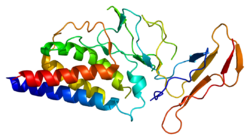Composition
IL-2 binds to the IL-2 receptor, which has three forms, generated by different combinations of three different proteins, often referred to as "chains": α (alpha) (also called IL-2Rα, CD25, or Tac antigen), β (beta) (also called IL-2Rβ, or CD122), and γ (gamma) (also called IL-2Rγ, γc, common gamma chain, or CD132); these subunits are also parts of receptors for other cytokines. [2] : 713 The β and γ chains of the IL-2R are members of the type I cytokine receptor family. [3]
Structure-activity relationships of the IL-2/IL-2R interaction
The three receptor chains are expressed separately and differently on various cell types and can assemble in different combinations and orders to generate low, intermediate, and high affinity IL-2 receptors.
The α chain binds IL-2 with low affinity, the combination of β and γ together form a complex that binds IL-2 with intermediate affinity, primarily on memory T cells and NK cells; and all three receptor chains form a complex that binds IL-2 with high affinity (Kd ~ 10−11 M) on activated T cells and regulatory T cells. The intermediate and high affinity receptor forms are functional and cause changes in the cell when IL-2 binds to them. [3]
The structure of the stable complex formed when IL-2 binds to the high affinity receptor has been determined using X-ray crystallography. The structure supports a model wherein IL-2 initially binds to the α chain, then the β is recruited, and finally γ. [3] [4] [5]
Signaling
The three IL-2 receptor chains span the cell membrane and extend into the cell, thereby delivering biochemical signals to the cell interior. The alpha chain does not participate in signaling, but the beta chain is complexed with an enzyme called Janus kinase 1 (JAK1), that is capable of adding phosphate groups to molecules. Similarly the gamma chain complexes with another tyrosine kinase called JAK3. These enzymes are activated by IL-2 binding to the external domains of the IL-2R. As a consequence, three intracellular signaling pathways are initiated, the MAP kinase pathway, the Phosphoinositide 3-kinase (PI3K) pathway, and the JAK-STAT pathway. [3] [4]
Once IL-2 binds to the high affinity receptor, the complex is rapidly internalized and has only a short time to signal. IL-2, IL-2Rβ, and γc are rapidly degraded, but IL-2Rα is recycled to the cell surface. Thus, the concentration of IL-2 and its receptor available determines the tempo, magnitude and extent of T cell immune responses. [3] [4]
IL-2 and its receptor have key roles in key functions of the immune system, tolerance and immunity, primarily via their direct effects on T cells. In the thymus, where T cells mature, they prevent autoimmune diseases by promoting the differentiation of certain immature T cells into regulatory T cells, which kill off other T cells that are primed to attack normal healthy cells in the body. IL-2/IL2R also promotes the differentiation of T cells into effector T cells and into memory T cells when the initial T cells is also stimulated by an antigen, thus helping the body fight off infections. [3] Through their role in the development of T cell immunologic memory, which depends upon the expansion of the number and function of antigen-selected T cell clones, they also have a key role in enduring cell-mediated immunity. [3] [4]
This page is based on this
Wikipedia article Text is available under the
CC BY-SA 4.0 license; additional terms may apply.
Images, videos and audio are available under their respective licenses.


